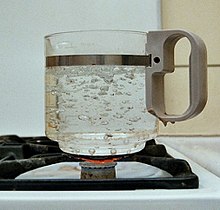Science: An Elementary Teacher’s Guide/Chemistry Objectives
Welcome to Chemistry!
[edit | edit source]
All around you, everything you touch and see, is made of atoms--the fundamental building blocks of chemistry. However, the atoms are usually not in a "pure" form of just one element. Instead, most things are combinations of multiple elements into new molecules. Different arrangements of atoms result in different physical and chemical properties--for example when 2 Hydrogen atoms combine with each other, they form H2, a gas that is less dense than normal air. This property is the reason it was used to fill the Hindenburg blimp. Unfortunately, it also has the property of being highly flammable, and while trying to dock the blimp caught fire and exploded! Fire itself is simply a rapid chemical reaction. In this case the Hydrogen gas (H2) was actually combining with Oxygen gas (O2) in the air and forming water (H2O).

Once those Hydrogen atoms have combined with Oxygen and formed water (H2O), these new molecules have entirely different properties and are decidedly NOT flammable.
The amount of matter on the earth is basically unchanged in the past 6 billion years (the only addition of matter comes from meteorites crashing to the earth). However, this matter can be rearranged again and again through chemical reactions and continues to be rearranged to this day (an analogy would be if you had a giant box of Legos--you could make endless new creations without getting any new Legos). However, just as it takes energy to make new Lego creations, many chemical reactions require energy to proceed. Life exists because of carefully-controlled chemical reactions. These reactions are taking place at an astonishing speed in every cell of every living thing! There are also chemical reactions that take place in the air, water, and ground without input from living things, but these generally proceed much slower, and not in a controlled fashion. Life has had a profound effect on the chemistry of the entire planet, even creating the composition of the atmosphere that allows us to breathe (and by the way, it is a change in your blood chemistry that causes the urge to breathe when you hold your breath). Chemistry explains how energy transfers from the sun, to the plants, to your body, so chemistry and biology are closely linked. Carl Sagan said, The beauty of a living thing is not the atoms that go into it, but the way those atoms are put together. Chemistry can also be studied with no relation to living things. Each year chemists invent thousands of new molecules and study their properties. Chemistry must obey all the laws of physics, and for any chemical reaction to proceed the right physical conditions must be present. Chemists figure out what conditions need to be met, and then the reactions can proceed quite quickly, like the making of this nylon.
Chemistry is a broad subject. If you want to learn more, here are some good resources:
- Bozeman Science chemistry videos
- Khan Academy chemistry lessons
- Hank Green's Crash Course Chemistry
- Professor Dave Explains Chemistry
- Wikipedia chemistry articles
- Whether or not a reaction will proceed spontaneously (no energy input) is a product of the Second Law of Thermodynamics (not the same as Newton's 2nd Law of Motion!)
